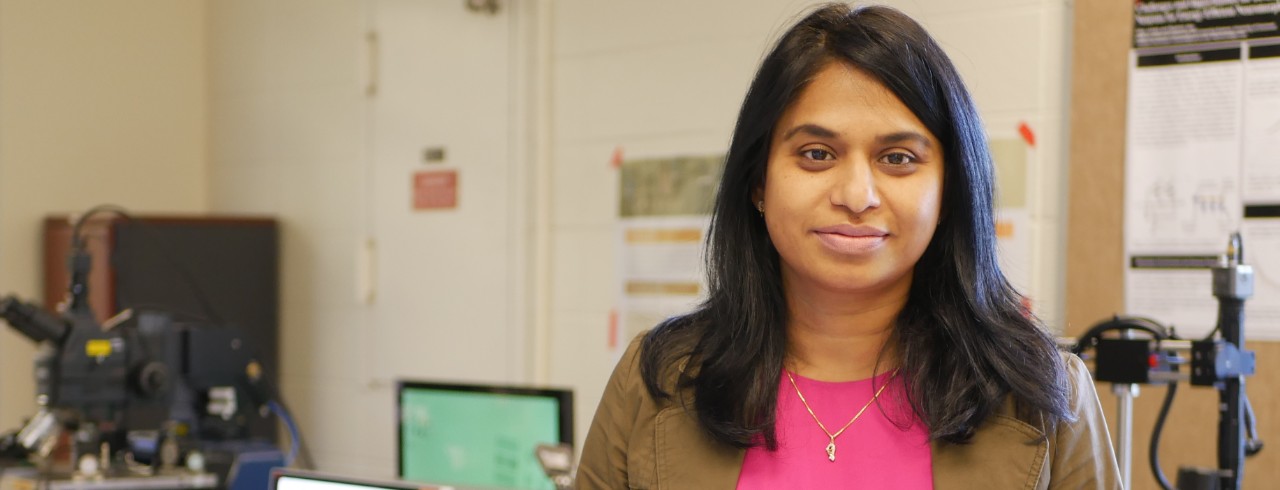
Electrical engineer finds inspiration in neuroscience for improving AI
UC researcher awarded NSF grant to make advanced AI available on a smaller scale
The capabilities of Artificial Intelligence are expanding at a rapid rate. AI is used in Apple’s Face ID on iPhone, Amazon’s Alexa assistant, self-driving cars and banking apps that remotely deposit checks, to name just a few. However, AI is still far from matching the learning capabilities of people.
To improve AI, University of Cincinnati researcher Rashmi Jha is exploring human neuroscience.
Advanced AI algorithms are data hogs – they require a ton of memory to function and “learn.” To truly harness and enhance the potential of AI, the technology requires extremely fast memory devices that can store a massive amount of data beyond what currently exists.
Jha, an associate professor in the Department of Electrical Engineering and Computer Science in UC’s College of Engineering and Applied Science, is working to create processing devices that can handle AI’s needs by taking inspiration from the connections made in the human brain, a research field called neuromorphic computing. Jha and her research team are working on a neuromorphic data processor that is made to mimic the neural synaptic connections our brains make to rapidly filter what we see and hear.
The goal is to create an artificial synaptic device that dramatically speeds up the process of AI machine learning while doing so on a device that is much smaller and requires less power than the hardware most AI systems currently rely on. Such a small-scale device could enable machine learning within your smartphone or on a health sensor, for example.
The work of Jha and her team of researchers demonstrates innovation and UC’s commitment to research as described in its strategic direction Next Lives Here.

Rashmi Jha is developing a small-scale neuromorphic data processor that could enable machine learning on devices much smaller than current technology allows. Photo/Corrie Mayer/CEAS Marketing.
In addition to creating hardware for AI, Jha and her team are studying ways to create novel real-time learning algorithms that are also based on how the human brain functions. This focus on mimicking the synapses and neurons of the human brain has led Jha to dive into the study of neuroscience to improve our understanding of brain function.
“A lot of these sensors and things over time will become an integral part of our life and we don’t want to be programming them all the time, we want them to be adaptable, which means they should learn from our behavior, choices we make or the type of things they experience along with us. They need to have their own ‘brain’ that can operate from a small lightweight battery. That is why the ability to do real-time learning at low power is extremely critical,” Jha said.
An example of potential use: If law enforcement is searching for a missing person with a drone that has a camera to take video in a crowd, currently, AI can be used offline once the video is collected to recognize someone in the footage. A low-power neuromorphic processor could enable the drone itself to conduct real-time image recognition as it flies.
Jha recently received a National Science Foundation grant to support this research. Another component of her work, which Jha is very passionate about, involves educational outreach to spur the interest of underrepresented groups in STEM fields. Jha and her team are working with Tonkia Bridges, a technology teacher and the executive director of a group for K-12 students called NERDS, Nurturing Educational Readiness and Development from the Start. NERDS seeks to engage young students in the Cincinnati area through after-school clubs. For the science-based clubs, Jha’s lab created easy-to-understand video modules and hands-on activities that serve as an introduction to neuromorphic computing.
“We created the modules to start nurturing kids’ interest in STEM early on, particularly something that is more futuristic,” Jha said. “This is a pilot program for us, we intend to partner with more elementary and middle schools, specifically for after-care or summer camps, beyond the standard robotics club.”

Rashmi Jha and doctoral students Alex Jones and Andy Ford make observations in Jha's MIND lab. Jha and her research team aim to create technology to advance AI capabilities.. Photo/Corrie Mayer/CEAS Marketing.
Related Stories
UC launches Bearcat Affordability Grant
January 7, 2026
The University of Cincinnati is making college more attainable for students across Ohio with the creation of the Bearcat Affordability Grant. The new grant will provide a pathway to tuition-free college for students of families who make less than $75,000 per year. Beginning in fall 2026, the Bearcat Affordability Grant will cover the remaining cost of tuition for Ohio residents who are Pell eligible.
How aerospace is turning to trustworthy AI
January 6, 2026
UC College of Engineering and Applied Science graduate Lynn Pickering talks to the Ohio Federal Research Network about her research into artificial intelligence and the future of AI in aerospace engineering.
UC biochemistry student explores world of taste
January 5, 2026
A University of Cincinnati biochemistry student changed her career trajectory after being inspired by internships with a European Fortune 500 company.
